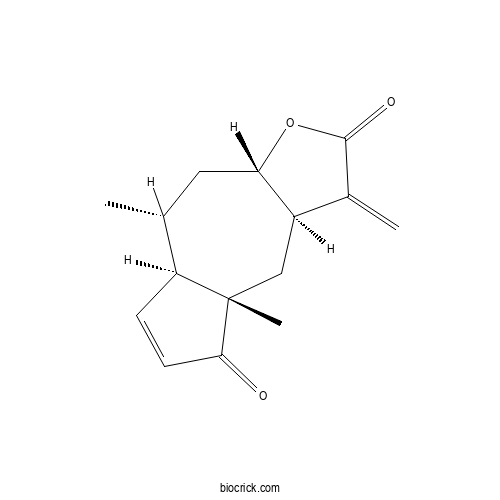AromaticinCAS# 5945-42-6 |

Quality Control & MSDS
3D structure
Package In Stock
Number of papers citing our products

| Cas No. | 5945-42-6 | SDF | Download SDF |
| PubChem ID | 282529.0 | Appearance | Powder |
| Formula | C15H18O3 | M.Wt | 246.12 |
| Type of Compound | N/A | Storage | Desiccate at -20°C |
| Solubility | Soluble in Chloroform,Dichloromethane,Ethyl Acetate,DMSO,Acetone,etc. | ||
| Chemical Name | (3aS,5R,5aR,8aS,9aR)-5,8a-dimethyl-1-methylidene-3a,4,5,5a,9,9a-hexahydroazuleno[6,7-b]furan-2,8-dione | ||
| SMILES | CC1CC2C(CC3(C1C=CC3=O)C)C(=C)C(=O)O2 | ||
| Standard InChIKey | OSSDUQKWVVZIGP-SCGWIAOYSA-N | ||
| Standard InChI | InChI=1S/C15H18O3/c1-8-6-12-10(9(2)14(17)18-12)7-15(3)11(8)4-5-13(15)16/h4-5,8,10-12H,2,6-7H2,1,3H3/t8-,10-,11+,12+,15+/m1/s1 | ||
| General tips | For obtaining a higher solubility , please warm the tube at 37 ℃ and shake it in the ultrasonic bath for a while.Stock solution can be stored below -20℃ for several months. We recommend that you prepare and use the solution on the same day. However, if the test schedule requires, the stock solutions can be prepared in advance, and the stock solution must be sealed and stored below -20℃. In general, the stock solution can be kept for several months. Before use, we recommend that you leave the vial at room temperature for at least an hour before opening it. |
||
| About Packaging | 1. The packaging of the product may be reversed during transportation, cause the high purity compounds to adhere to the neck or cap of the vial.Take the vail out of its packaging and shake gently until the compounds fall to the bottom of the vial. 2. For liquid products, please centrifuge at 500xg to gather the liquid to the bottom of the vial. 3. Try to avoid loss or contamination during the experiment. |
||
| Shipping Condition | Packaging according to customer requirements(5mg, 10mg, 20mg and more). Ship via FedEx, DHL, UPS, EMS or other couriers with RT, or blue ice upon request. | ||

Aromaticin Dilution Calculator

Aromaticin Molarity Calculator
| 1 mg | 5 mg | 10 mg | 20 mg | 25 mg | |
| 1 mM | 4.0631 mL | 20.3153 mL | 40.6306 mL | 81.2612 mL | 101.5765 mL |
| 5 mM | 0.8126 mL | 4.0631 mL | 8.1261 mL | 16.2522 mL | 20.3153 mL |
| 10 mM | 0.4063 mL | 2.0315 mL | 4.0631 mL | 8.1261 mL | 10.1576 mL |
| 50 mM | 0.0813 mL | 0.4063 mL | 0.8126 mL | 1.6252 mL | 2.0315 mL |
| 100 mM | 0.0406 mL | 0.2032 mL | 0.4063 mL | 0.8126 mL | 1.0158 mL |
| * Note: If you are in the process of experiment, it's necessary to make the dilution ratios of the samples. The dilution data above is only for reference. Normally, it's can get a better solubility within lower of Concentrations. | |||||

Calcutta University

University of Minnesota

University of Maryland School of Medicine

University of Illinois at Chicago

The Ohio State University

University of Zurich

Harvard University

Colorado State University

Auburn University

Yale University

Worcester Polytechnic Institute

Washington State University

Stanford University

University of Leipzig

Universidade da Beira Interior

The Institute of Cancer Research

Heidelberg University

University of Amsterdam

University of Auckland

TsingHua University

The University of Michigan

Miami University

DRURY University

Jilin University

Fudan University

Wuhan University

Sun Yat-sen University

Universite de Paris

Deemed University

Auckland University

The University of Tokyo

Korea University
- Carpesiolin
Catalog No.:BCX0948
CAS No.:63568-73-0
- MangostanaxanthoneIV
Catalog No.:BCX0947
CAS No.:2182593-73-1
- GarcixanthonesB
Catalog No.:BCX0946
CAS No.:2522597-99-3
- 11-hydroxy-1-isomangostin
Catalog No.:BCX0945
CAS No.:164365-71-3
- CompoundK
Catalog No.:BCX0944
CAS No.:160729-91-9
- Lycobetaineacetate
Catalog No.:BCX0943
CAS No.:61221-41-8
- Harmalinehydrochloridedihydrate
Catalog No.:BCX0942
CAS No.:6027-98-1
- 14-hydroxylatedbrassinosteroid
Catalog No.:BCX0941
CAS No.:457603-63-3
- (S)-(-)-Norcoclaurinehydrobromide
Catalog No.:BCX0940
CAS No.:105990-27-0
- PhlorigidosideC
Catalog No.:BCX0939
CAS No.:276691-32-8
- β-Elemene
Catalog No.:BCX0938
CAS No.:515-13-9
- Ginno
Catalog No.:BCX0937
CAS No.:2606-50-0
- Nepetin7-O-β-D-glucopyranoside
Catalog No.:BCX0950
CAS No.:1627598-00-8
- SpicatosideA
Catalog No.:BCX0951
CAS No.:128397-47-7
- Nitidine
Catalog No.:BCX0952
CAS No.:6872-57-7
- (25R)-Spirost-4-en-3,12-dion
Catalog No.:BCX0953
CAS No.:6875-60-1
- ThonningianinB
Catalog No.:BCX0954
CAS No.:271579-12-5
- Dehydroeburicoic acid monoacetate
Catalog No.:BCX0955
CAS No.:77035-42-8
- 10-Hydroxycamptothecin acetate
Catalog No.:BCX0956
CAS No.:951770-22-2
- Liquiritigenin-7-O-apiosyl(1-2)-glucoside
Catalog No.:BCX0957
CAS No.:135432-48-3
- Furo[3',4':6,7]naphtho[2,3-d]-1,3-dioxol-6(5aH)-one,5,8,8a,9-tetrahydro-5-(3,4,5-trimethoxyphenyl)- (9CI)
Catalog No.:BCX0958
CAS No.:69222-20-4
- 1,5-di-O-p-coumaroylquinicacid
Catalog No.:BCX0959
CAS No.:1239620-73-5
- 1-O-trans-caffeoyl-5-O-trans-p-coumaroylquinicacid
Catalog No.:BCX0960
CAS No.:1401532-34-0
- 1-p-coumaroyl-3-caffeoylquinicacid
Catalog No.:BCX0961
CAS No.:2459224-35-0
Solution and solid-state effects on NMR chemical shifts in sesquiterpene lactones: NMR, X-ray, and theoretical methods.[Pubmed:22145745]
J Phys Chem A. 2012 Jan 12;116(1):680-8.
Selected guaianolide type sesquiterpene lactones were studied combining solution and solid-state NMR spectroscopy with theoretical calculations of the chemical shifts in both environments and with the X-ray data. The experimental (1)H and (13)C chemical shifts in solution were successfully reproduced by theoretical calculations (with the GIAO method and DFT B3LYP 6-31++G**) after geometry optimization (DFT B3LYP 6-31 G**) in vacuum. The GIPAW method was used for calculations of solid-state (13)C chemical shifts. The studied cases involved two polymorphs of helenalin, two pseudopolymorphs of 6alpha-hydroxydihydro-Aromaticin and two cases of multiple asymmetric units in crystals: one in which the symmetry-independent molecules were connected by a series of hydrogen bonds (geigerinin) and the other in which the symmetry-independent molecules, deprived of any specific intermolecular interactions, differed in the conformation of the side chain (badkhysin). Geometrically different molecules present in the crystal lattices could be easily distinguished in the solid-state NMR spectra. Moreover, the experimental differences in the (13)C chemical shifts corresponding to nuclei in different polymorphs or in geometrically different molecules were nicely reproduced with the GIPAW calculations.


